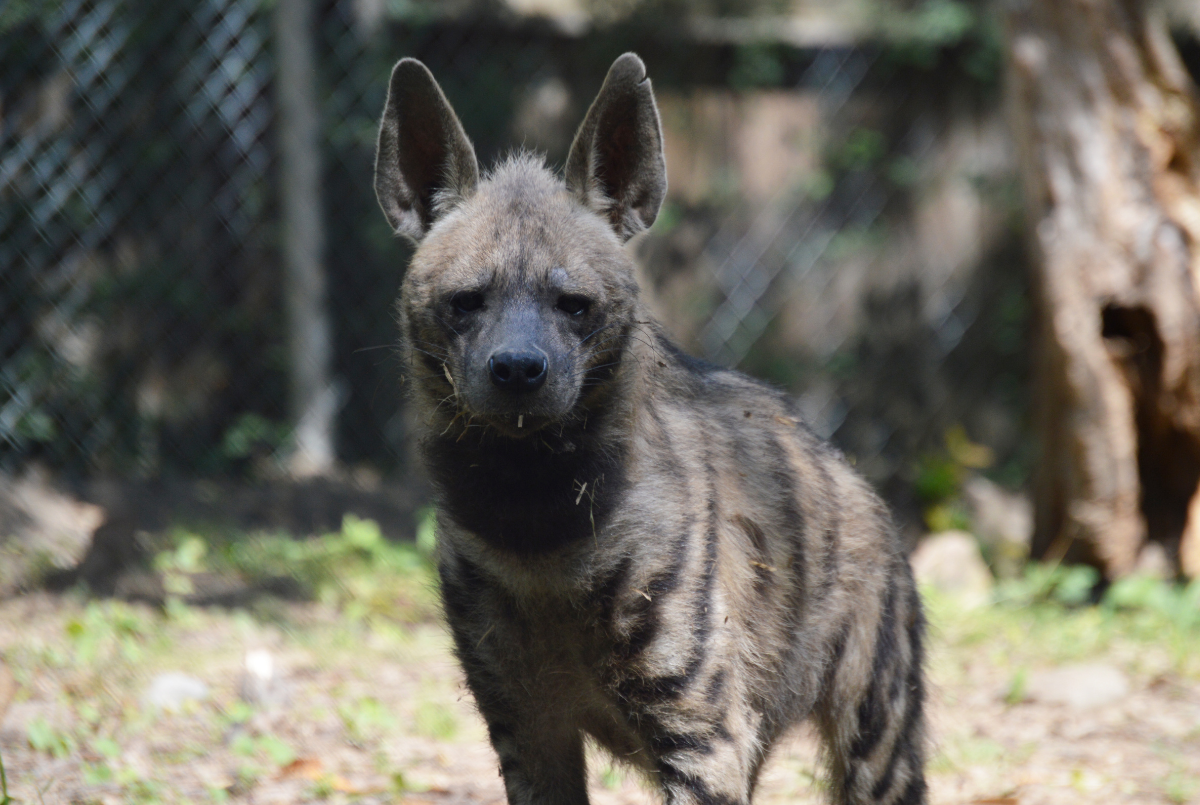Striped Hyena

Basic Information:
Scientific Name: Hyaena hyaena
Habitat: Striped hyenas reside in the semideserts, rocky scrublands, and savannas of northern Africa, the Middle East, and India.
Diet: Striped hyenas are scavengers meaning that they primarily eat carrion (or the decaying flesh of dead animals).
Size: 2 to 2.6 feet tall / 2.8 to 4.3 feet long
Weight: 49-120 pounds
Lifespan: 12 years in the wild. Up to 23 years in human care.
Distribution Map:
I.U.C.N Conservation Status:

What does this mean?
Near Threatened – a species that is determined by the International Union for Conservation of Nature (I.U.C.N.) to be declining in population and may meet the criteria for a threatened status in the near future.
Our Striped Hyenas:
Kani (Male) – Born May 15, 2012
Imara (Female) – Born February 22, 2013
About Striped Hyenas:
Striped hyenas are one of the 3 types of hyena species in the world. They can be found stretching from Asian countries such as India and Pakistan all the way into north African countries and as far west as Senegal and Mauritania. They prefer grasslands, open woodlands, and bushy and rugged regions where they travel in small groups and feed on carrion that is left around their habitat. A striped hyena’s massive jaws help them crush and swallow bones, teeth, horns, and hooves—all body parts that other predators leave uneaten. Their jaw pressure is approximately 800lbs per square inch. The hyena’s digestive system has adapted to maximize the nutritional value of animal remains. It contains highly acidic fluids, in which the organic matter of bone is usually digested completely while indigestible items like small bone fragments, horns, hooves, and hair are regurgitated. All this being said, hyenas are also skilled hunters able to take down relatively large prey. Some striped hyenas even prey on sheep, goats, donkeys, and horses. They are also known to eat crops such as dates, melons, cucumbers, and peaches (a favorite). Unlike their noisy cousins the spotted hyenas, striped hyenas do not make that famous laugh-like sound and are usually silent. Their loudest call is a rarely heard, cackling howl. Instead they generally rely more on body language as a means of communication. For example, when they feel threatened they may attempt to make themselves look much larger by raising the hair/mane along their back. It’s generally their last effort to “pretend” to be brave and, hopefully, keep what it sees as scary predators farther away.
Did You Know?!
- A young striped hyena is called a cub, pup, or whelp. A striped hyena group is called a clan or cackle.
- A striped hyena’s diet varies by season. True to its scavenger nature, a hyena eats mammalian carrion whenever possible.
- Initial observation of these hyenas concluded that they were a solitary species, but recent studies have begun to disprove that! It is now believed that striped hyenas enjoy living in small groups of one female and several males.
- Primarily nocturnal or crepuscular, Striped hyenas rest out of sight during the day in a natural cave or a burrow dug into the hillside. Hyenas have even been known to take over other animals’ dens.
- Striped hyenas are not members of the dog or cat families. Although of the two, they are more closely related to the cat family. Instead, they are so unique that they have a family all their own: Hyaenidae. There are four members of the Hyaenidae family: the striped hyena, the spotted hyena, the brown hyena, and the aardwolf.
- While the striped hyena has no natural predators, it does often come into conflict with humans. They have been known to kill humans, especially children, and they are often poisoned and trapped for preying on livestock or raiding farms. Some of their body parts are also believed to have medicinal value.
- The front legs of a striped hyena are much longer than their hind legs. This gives hyenas their distinctive walk that makes them seem like they’re always limping uphill.
- Striped hyenas seem to be immune to certain diseases such as rabies and anthrax. By studying their immune system, we might find cures for humans.
